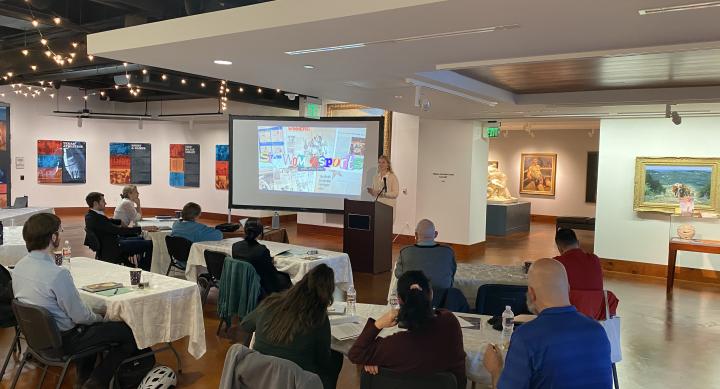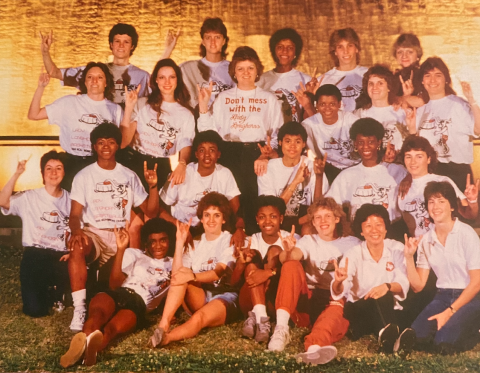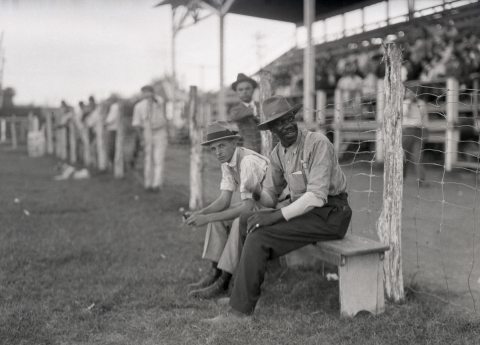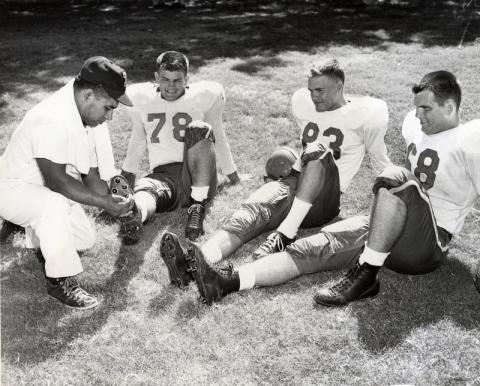
Erin Crownover, Ph.D. student in the Kinesiology and Health Education program, examines the development of the athletic training profession from its origins through a case study of past UT Austin athletic trainers.
The enactment of Title IX—the landmark 1972 Federal legislation that prohibits discrimination based on sex in education programs—was a key step that helped pave the way for broader participation of women in college sports. However, it would be decades before female athletes began to receive the attention and resources needed to help them thrive.

Few figures have contributed more to the advancement of women in college sports following the enactment of Title IX than Christina (Tina) Bonci, who pioneered the field of women’s athletics and collegiate sports medicine as the head women’s athletic trainer at UT Austin for nearly three decades.
From 1985 to 2014, Bonci’s groundbreaking contributions not only advanced the athletic training profession but also reshaped the narrative of healthcare for female athletes. A champion of holistic athlete wellness, Bonci pioneered research and initiatives focusing on issues uniquely affecting women in sports, such as injury prevention, eating disorders and bone health.
Through her collaboration with UT Austin’s athletics programs, Bonci redefined athletic training as a holistic and inclusive discipline that bridges physical performance and mental health, emphasizing inclusivity and individualized care.
New research at UT Austin is shedding light on the pivotal contributions of the University on the field of women’s athletics through an examination of its athletic training professionals. Erin Crownover, Ph.D. student in the Kinesiology and Health Education program, examines the development of the athletic training profession from its origins through a case study of past UT Austin athletic trainers.
A third-generation UT Austin student, Crownover is writing her dissertation on three key figures—Henry “Doc” Reeves, Frank Medina, and Christina (Tina) Bonci—and how athletic training evolved within collegiate sports medicine and how these individuals contributed to both the University and the broader field.

Crownover’s research investigates the historical, social and scientific contexts that shaped athletic training, particularly its marginalization due to the lack of formal medical status and highlights how these three professionals helped legitimize and advance the discipline. By bringing their stories to light, her study contributes to a deeper understanding of the profession’s origins, institutional dynamics and cultural impact within sports history.
Crownover took some time out of her studies to answer some questions about her research and time at UT Austin.
Can you briefly describe your research and its main objective?
My research examines the early athletic training profession, using The University of Texas at Austin as a case study. Specifically, I am analyzing three key figures in the history of athletic training at Texas: Henry “Doc” Reeves, Frank Medina, and Christina (Tina) Bonci.
The field of athletic training has long been an outlier in sports medicine, striving for representation due to the lack of doctor status among practitioners. My dissertation explores this dynamic and the historical, social and scientific factors that led to the development of the early athletic training profession at the collegiate level, specifically at UT Austin. The stories of Reeves, Medina and Bonci provide a window into the history of the broader impact/story of the profession’s development in the 20th Century. The contributions and lives of these three historical figures have been impactful not just at UT Austin but for the field of athletic training as a whole.
What sparked your interest in this topic?
I was a former collegiate athlete with multiple ACL injuries, so I spent a lot of time with sports medicine professionals, including athletic trainers. These experiences and my undergraduate education led me to initially pursue my master’s in Kinesiology (with a concentration in Exercise Physiology) here at UT Austin. During this time, I learned about the Male and Female Athlete Triad and RED-S and how they correlated to my experiences as an athlete.
During my second year of my master’s, I took a course with Dr. Jan Todd on the History of Exercise Science. Throughout that course, I learned more about women's history in athletics, especially regarding menstruation and performance. This is when I discovered who Tina Bonci was, a former athletic trainer at UT Austin, from reading her position statement on eating disorders and how they impact menstruation and performance. I was hooked and wanted to keep learning more!

What were some of the challenges or limitations you encountered during the research process?
Coming from an exercise science-based background in my bachelor’s and master’s, it was a big transition to the world of sports history. I had to learn how to rewire my train of thinking, and I did not have a ton of coursework in history-based classes under my belt. Thankfully, my advisor has been very supportive, and I have been able to take multiple history courses (starting with some undergrad-level ones) to work my way up.
I have also learned more about archival research and that it takes time and patience—you never know what you may find or not find, but either way, it provides you with information. This was very different from the science world, where the objective was to find a straightforward answer. Archival work as a historian is like being a detective, with one clue leading to another!
What is the potential impact or significance of your research?
The culture of college athletics is complex, and an institution like UT Austin has historically been both a site of exclusion and opportunity for minority men and women students, student-athletes, coaches, sports medicine staff, and campus faculty and staff. My dissertation is valuable because it addresses historical inequities, institutional shifts (i.e., not many people know that our athletic department was once separated between men and women), and the broader societal impact of athletics that one component of a sports medicine department had. I am bringing three marginalized voices to the forefront that have helped shape the modern-day field of athletic training.
What do you find most exciting or rewarding about doing this research?

Discovering and telling the stories of people who have not been shared. Two of the three individuals I am discussing in my dissertation still have family and friends alive, and I have been very grateful to have been able to interview them. It is really rewarding to hear stories and see the emotions of the impact the athletic trainers I am writing about have had not only on the community of UT Austin but on the City of Austin, friends and family, and the country at large. These folks are greatly missed, and their stories deserve to be told!
Are there any specific questions or areas you'd like to explore further?
Eventually, I want to explore further the history of early athletic training in examining enslaved African and African American women and if there is further information on them, being sources of medicinal knowledge (many serving as midwives and healers) and how that was passed on to their children. Early athletic trainer roles at institutions (such as UT Austin) were held by Black men, and I believe there is a connection between them.
What advice would you give to other students who are considering pursuing research?
My adviser told me when I began my Ph.D. that learning is like an amoeba: you are constantly engaging with new information and forming new ideas that are absorbed and integrated into your existing knowledge and understanding. These connections take time—it won’t happen immediately, so patience is key! Keep reading and asking the “why?” or “so what?” questions of what you are studying, and you will start to see connections being made and lightbulbs will start to go off in your head.

What has been your favorite aspect of attending UT Austin?
This is tough to answer! Discovering and having access to The H.J. Lutcher Stark Center for Physical Culture and Sports is a big highlight. What other grad program has access to an archive and museum dedicated to studying and preserving the world of physical culture and sport? Plus, it is the official archive for Texas Athletics! It’s amazing that we have access to this. The Stark Center is a hidden gem on campus that everyone truly would benefit from visiting!

